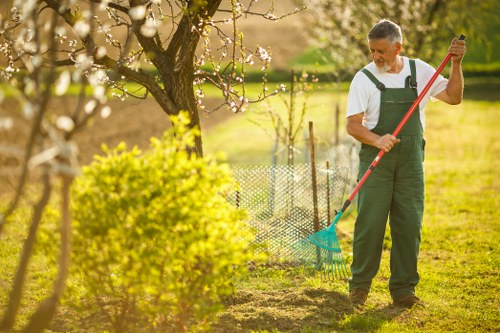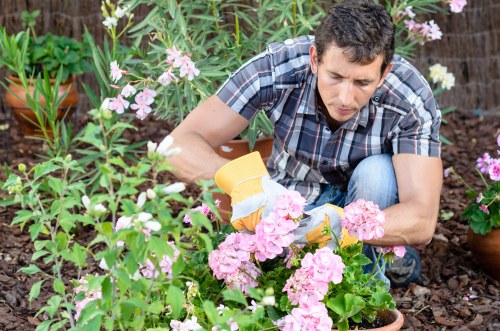Lawn Mowing in Chingford: Keeping Your Lawn Pristine All Year Round

Why Regular Lawn Mowing is Essential
Maintaining a beautiful lawn is not just about aesthetics; it plays a crucial role in the overall health of your garden. In Chingford, where gardening enthusiasts take pride in their outdoor spaces, regular lawn mowing ensures that your grass remains healthy and vibrant throughout the seasons.
Proper lawn maintenance helps prevent weeds from taking over, reduces the risk of pests, and promotes the growth of thick, lush grass. By keeping your lawn well-mowed, you’re also contributing to the curb appeal of your home, making it more inviting and enjoyable.
Moreover, a well-maintained lawn provides a safe and comfortable space for outdoor activities, whether it’s a family gathering, a weekend barbeque, or simply relaxing in the sun. Investing time and effort into regular mowing can significantly enhance the quality and functionality of your outdoor area.

Choosing the Right Lawn Mowing Service in Chingford
When it comes to lawn mowing services in Chingford, selecting the right provider is crucial for achieving the best results. Professional lawn care experts offer a range of services tailored to meet the unique needs of each property, ensuring that your lawn receives the care it deserves.
Consider factors such as the experience of the service provider, the equipment they use, and the range of services they offer. A reputable lawn mowing company should be able to handle everything from basic mowing to more specialized tasks like edging, fertilizing, and pest control.
Additionally, check for customer reviews and testimonials to gauge the quality of service. A company with positive feedback and a strong reputation in Chingford is more likely to provide reliable and efficient lawn mowing services that meet your expectations.

The Benefits of Professional Lawn Mowing
Opting for a professional lawn mowing service in Chingford offers numerous advantages. Professionals possess the necessary expertise and equipment to deliver superior results, ensuring that your lawn is cut to the optimal height and maintained consistently.
Regular professional mowing not only enhances the appearance of your lawn but also contributes to its health. Experts can identify potential issues such as diseases or pest infestations early on, allowing for timely intervention and treatment. This proactive approach prevents minor problems from escalating into major concerns.
Moreover, professional services save you time and effort, allowing you to focus on other aspects of property maintenance or simply enjoy your free time. With reliable and efficient lawn care, you can rest assured that your outdoor space is in good hands.

Essential Lawn Care Tips for Chingford Homeowners
Maintaining a healthy lawn in Chingford requires more than just regular mowing. Implementing comprehensive lawn care practices can significantly improve the overall health and appearance of your grass.
Proper Mowing Techniques
- Keep your mower blades sharp to ensure clean cuts and prevent damage to the grass.
- Avoid cutting more than one-third of the grass blade length in a single mowing session to reduce stress on the lawn.
- Vary your mowing pattern regularly to promote even growth and prevent soil compaction.
Watering Practices
- Water your lawn early in the morning or late in the evening to minimize evaporation and ensure optimal absorption.
- Aim for deep, infrequent watering to encourage deep root growth, making your lawn more resilient to drought conditions.
- Adjust watering schedules based on weather conditions and seasonal changes to maintain consistent moisture levels.
Fertilization and Soil Health
- Apply a balanced fertilizer suitable for your lawn type to provide essential nutrients.
- Conduct soil tests periodically to determine nutrient deficiencies and amend the soil accordingly.
- Incorporate organic matter, such as compost, to improve soil structure and fertility.
Implementing these practices ensures that your lawn remains robust, green, and free from common issues that can detract from its beauty and functionality.

Seasonal Lawn Maintenance in Chingford
Each season presents unique challenges and opportunities for lawn care. Understanding the specific needs of your grass throughout the year can help you maintain a lush, healthy lawn in Chingford.
Spring
- Begin regular mowing as the grass starts to grow, gradually increasing the frequency.
- Apply a balanced fertilizer to promote new growth and strengthen the grass against pests and diseases.
- Remove any debris, such as leaves or branches, to prevent mold and encourage healthy growth.
- Overseeding bare patches to ensure uniform grass coverage.
- Aerate the lawn to enhance soil permeability and nutrient uptake.
Summer
- Ensure consistent watering to combat the heat and prevent the grass from drying out.
- Continue regular mowing, adjusting the cutting height to accommodate growth rates.
- Monitor for pests and diseases, treating them promptly to avoid extensive damage.
- Mulch the lawn to retain moisture and suppress weed growth.
- Provide adequate shade or adjust watering schedules during extreme heat waves.
Autumn
- Prepare the lawn for winter by reducing mowing frequency.
- Apply a high-phosphorus fertilizer to promote root growth.
- Remove fallen leaves and debris to prevent fungal growth and suffocation of the grass.
- Overseed as needed to fill in thinning areas and enhance lawn density.
- Conduct a final aeration session to ensure soil health going into the colder months.
Winter
- Minimize foot traffic to prevent soil compaction and grass damage.
- Remove any snow or ice from the lawn to prevent mold and mildew.
- Plan for any necessary repairs or renovations to lawn equipment for the upcoming season.
- Protect delicate grass areas with mulch or other insulating materials.
- Monitor for winter pests and take preventive measures as needed.

Advanced Lawn Care Techniques
For homeowners looking to take their lawn maintenance to the next level, implementing advanced techniques can provide exceptional results. Techniques such as aeration, dethatching, and overseeding contribute to the long-term health and resilience of your lawn.
Aeration
Aeration involves perforating the soil to allow air, water, and nutrients to penetrate the grassroots. This process helps alleviate soil compaction, promoting healthier root growth and improving overall lawn density.
- Benefits of aeration include enhanced nutrient uptake and improved resistance to drought and disease.
- It's recommended to aerate your lawn at least once a year, preferably during the growing season.
Dethatching
Dethatching removes the layer of dead grass and organic matter that can build up between the soil and the green grass blades. Reducing thatch levels prevents moisture loss and encourages better nutrient absorption.
- Use a dethatching rake or machine for effective removal.
- Regular dethatching helps maintain a healthy lawn structure and appearance.
Overseeding
Overseeding involves spreading grass seed over an existing lawn to fill in bare spots and improve grass density. This technique enhances the lawn's resilience and aesthetic appeal.
- Select grass seed that matches your existing lawn type for uniformity.
- Ensure proper soil preparation and watering to promote successful germination.
Incorporating these advanced techniques into your lawn care routine can lead to a more robust and attractive lawn, capable of withstanding the challenges posed by different weather conditions.

Eco-Friendly Lawn Mowing Practices
Adopting eco-friendly practices in lawn mowing not only benefits your lawn but also contributes to environmental sustainability in Chingford.
Use of Electric or Manual Mowers
- Opt for electric or manual mowers instead of gas-powered ones to reduce carbon emissions and noise pollution.
- Electric mowers are often lighter, quieter, and easier to maintain, providing a greener alternative for lawn care.
- Manual mowers, such as reel mowers, offer a completely emission-free mowing experience.
Grass Clipping Mulching
- Mulching mowers finely chop grass clippings and redistribute them onto the lawn, providing natural fertilizer and reducing waste.
- This practice helps retain soil moisture, suppresses weeds, and returns essential nutrients to the grass.
- Mulched grass clippings decompose quickly, enriching the soil's organic matter content.
Water Conservation Techniques
- Implement smart irrigation systems that adjust watering schedules based on weather conditions.
- Use rainwater harvesting methods to utilize natural water sources for lawn irrigation.
- Employ drip irrigation or soaker hoses to deliver water directly to the root zones, minimizing evaporation.
By integrating these eco-friendly practices, you not only maintain a healthy lawn but also contribute positively to the environment, making your lawn care routine sustainable and responsible.

Understanding Lawn Types in Chingford
Different types of grass require specific care routines to thrive in Chingford’s climate. Understanding the type of lawn you have is crucial for implementing effective maintenance strategies.
Bermuda Grass
- Thrives in warm climates and requires regular mowing and fertilization to maintain its dense growth.
- Resistant to drought and pests, making it ideal for Chingford’s varying weather conditions.
- Best suited for full sun areas and can be aggressive in spreading, filling in gaps effectively.
Fescue Grass
- Prefers cooler climates and performs well in shaded areas.
- Requires less frequent mowing but benefits from regular watering and fertilization to stay healthy.
- Known for its fine texture and rich green color, making it a popular choice for ornamental lawns.
Ryegrass
- Establishes quickly and is often used for overseeding in cooler seasons.
- Offers a bright green color and fine texture, enhancing the lawn’s overall appearance.
- Requires consistent watering and regular mowing to maintain its vigorous growth.
St. Augustine Grass
- Grows well in warm and humid climates, providing a thick and durable lawn.
- Requires moderate mowing and regular irrigation to thrive.
- Known for its broad blades and ability to tolerate foot traffic, making it ideal for active lawns.
Choosing the right grass type for your lawn can significantly impact its maintenance requirements and overall health. Consulting with a lawn care professional in Chingford can help you select the most suitable grass variety for your specific needs and conditions.

Common Lawn Mowing Mistakes to Avoid
Avoiding common mistakes can significantly enhance the effectiveness of your lawn mowing routine. Here are some pitfalls to watch out for:
Cutting the Grass Too Short
- Cutting grass too short can stress the lawn, making it more susceptible to weeds and diseases.
- A general rule is to never remove more than one-third of the grass blade length during a single mowing session.
- Maintaining the proper grass height encourages deeper root growth and a healthier lawn.
Mowing When the Grass is Wet
- Mowing wet grass can lead to uneven cuts, clogging of mower blades, and potential damage to the lawn.
- Wait for the grass to dry before mowing to ensure a clean and efficient cut.
- Mowing wet grass increases the risk of spreading fungal diseases across your lawn.
Ignoring Lawn Edging
- Proper edging creates a neat boundary between your lawn and adjacent surfaces like pathways or flower beds.
- Using an edge trimmer or manual edging tools can enhance the overall appearance of your lawn.
- Edging helps prevent grass from encroaching into unwanted areas, maintaining a tidy and organized garden space.
Using Dull Mower Blades
- Dull blades tear the grass rather than cut it cleanly, leading to a ragged appearance and increased vulnerability to diseases.
- Regularly sharpen mower blades to ensure smooth and precise cuts.
- Replace blades that are excessively worn or damaged to maintain mowing efficiency.
By being mindful of these common mistakes, you can improve the health and appearance of your lawn, ensuring it remains a vibrant and inviting part of your Chingford home.

The Role of Technology in Modern Lawn Mowing
Technology has revolutionized lawn care, making modern mowing techniques more efficient and effective. Innovations such as robotic mowers and smart irrigation systems are transforming how homeowners maintain their lawns in Chingford.
Robotic Mowers
- Robotic mowers autonomously maintain your lawn, ensuring consistent mowing patterns and optimal grass height.
- These devices operate quietly and can be programmed to suit your lawn’s specific needs, providing a hands-free mowing solution.
- Advanced models come with sensors and GPS technology to navigate around obstacles and adapt to changing lawn conditions.
Smart Irrigation Systems
- Smart irrigation systems use sensors and weather data to adjust watering schedules automatically, conserving water and ensuring your lawn receives the right amount of moisture.
- These systems can be integrated with your lawn mowing schedule for a seamless maintenance experience.
- Remote monitoring and control features allow you to manage your irrigation system from your smartphone or other devices.
Automated Lawn Care Apps
- Mobile applications provide scheduling, reminders, and tips for effective lawn care management.
- Some apps offer integration with smart home devices, allowing for comprehensive lawn care automation.
- Users can track lawn health, receive personalized care recommendations, and manage service appointments through these apps.
Embracing these technological advancements can lead to a more efficient and effective lawn care routine, saving time and enhancing the health and appearance of your lawn in Chingford.
Cost Considerations for Lawn Mowing Services
Understanding the cost factors associated with professional lawn mowing services in Chingford can help you make informed decisions about your lawn care investments.
Factors Influencing Cost
- Size of the Lawn: Larger lawns require more time and resources, affecting the overall cost.
- Frequency of Service: Regular mowing contracts may offer discounted rates compared to one-time services.
- Additional Services: Specialized services like fertilizing, aeration, and pest control can add to the total cost.
- Equipment and Labor: High-quality equipment and experienced labor may come at a higher price but ensure superior results.
- Seasonal Considerations: Certain times of the year may demand more intensive care, influencing service costs.
Budgeting for Lawn Care
- Establish a budget that accounts for both regular maintenance and unexpected lawn care needs.
- Compare quotes from multiple service providers to ensure you’re getting the best value for your investment.
- Consider long-term benefits and cost savings associated with maintaining a healthy and attractive lawn, such as increased property value and reduced need for repairs.
- Allocate funds for essential equipment maintenance to prolong the life of your lawn care tools.
- Explore package deals or seasonal promotions offered by lawn care companies to maximize your budget.
Cost-Saving Tips
- Perform regular maintenance tasks yourself to reduce reliance on professional services.
- Invest in high-quality, efficient equipment that can handle various lawn care tasks, minimizing the need for additional services.
- Plan and schedule services during off-peak seasons when rates may be lower.
- Utilize eco-friendly practices, such as mulching and proper watering techniques, to maintain lawn health without excessive spending.
- Seek out local lawn care programs or community initiatives in Chingford that offer discounts or support for sustainable lawn maintenance.
By carefully considering these factors and implementing cost-saving strategies, you can manage your lawn care budget effectively while maintaining a beautiful and healthy lawn in Chingford.
DIY vs. Professional Lawn Mowing
Deciding between DIY lawn mowing and hiring professional services depends on various factors, including time, expertise, budget, and personal preferences.
Advantages of DIY Lawn Mowing
- Cost Savings: Eliminates labor costs associated with hiring professionals.
- Flexibility to mow at your convenience and schedule.
- Personal satisfaction and control over the quality of work.
- Opportunity to engage in physical activity and outdoor time.
- Customization of mowing techniques and patterns to suit your lawn’s specific needs.
Disadvantages of DIY Lawn Mowing
- Time-Consuming: Regular mowing and maintenance can be labor-intensive.
- Equipment Costs: Initial investment in quality mowers and maintenance tools can be significant.
- Skill Requirements: Achieving a professional-quality lawn may require knowledge and experience.
- Physical Effort: Mowing large or uneven lawns can be physically demanding.
- Inconsistent Results: Lack of expertise may lead to uneven cuts or potential lawn damage.
Advantages of Professional Lawn Mowing
- Expertise and Experience: Professionals understand the best practices for lawn care specific to Chingford’s climate and soil conditions.
- Time Efficiency: Saves you valuable time by handling all aspects of lawn mowing and maintenance.
- Access to Quality Equipment: Professionals use high-grade tools and machinery that may not be affordable for individual homeowners.
- Consistent Results: Ensures a uniform and well-maintained appearance year-round.
- Additional Services: Access to a range of lawn care services beyond mowing, such as fertilization and pest control.
Disadvantages of Professional Lawn Mowing
- Higher Costs: Ongoing professional services can add up over time.
- Scheduling Constraints: You may need to work around the service provider’s availability.
- Less Personal Control: Limited ability to influence specific mowing techniques or patterns.
- Dependence on Service Quality: Relying on external providers means varying levels of service quality based on the company chosen.
Ultimately, the choice between DIY and professional lawn mowing depends on your individual circumstances, priorities, and the specific needs of your lawn. Assessing the pros and cons of each option can help you make the best decision for maintaining a healthy and attractive lawn in Chingford.
Preparing Your Lawn for Mowing
Proper preparation before mowing can enhance the effectiveness of your lawn care routine and promote healthier grass growth.
Clearing the Lawn
- Remove any debris such as leaves, twigs, and sticks that can obstruct the mower blades.
- Clear away rocks and other hard objects that could damage the mower or injure you during mowing.
- Ensure pathways and flower beds are free from overgrown vegetation to prevent interference with mowing patterns.
Inspecting and Maintaining Equipment
- Regularly inspect your mower for any signs of wear or damage before each use.
- Clean the mower deck to prevent buildup of grass clippings that can affect cutting efficiency.
- Check and replace mower blades as needed to maintain sharpness and ensure clean cuts.
- Ensure that fuel levels and oil are adequate for gas-powered mowers.
- Charge or replace batteries for electric or battery-powered mowers to ensure uninterrupted operation.
Setting the Correct Mowing Height
- Adjust your mower to the appropriate cutting height based on the type of grass you have.
- Generally, higher cutting heights encourage deeper root growth and greater drought resistance.
- Avoid cutting too low, as it can stress the grass and make it more vulnerable to pests and diseases.
- Seasonally adjust mowing heights to accommodate changes in grass growth rates.
Timing Your Mowing
- Mow your lawn during the optimal time of day, typically in the late morning or early afternoon when the grass is dry and actively growing.
- Avoid mowing during the hottest parts of the day to reduce stress on the grass.
- Allow a few hours between watering and mowing to ensure the grass is dry enough for effective cutting.
By following these preparation steps, you can ensure that each mowing session is efficient, effective, and contributes to the overall health and beauty of your lawn.
Dealing with Lawn Pests and Diseases
Maintaining a healthy lawn in Chingford involves not only regular mowing but also vigilance against common pests and diseases that can compromise grass health.
Common Lawn Pests
- Grubs: These are the larvae of beetles that feed on grass roots, causing brown patches and weakening the lawn.
- Armyworms: Caterpillars that chew on grass blades, leading to significant damage if left untreated.
- Chinch Bugs: Insects that suck sap from grass stems, causing wilting and discoloration.
- Termites: Though primarily known for wood damage, termites can also affect grassy areas.
Common Lawn Diseases
- Powdery Mildew: A fungal disease that causes a white, powdery coating on grass blades.
- Red Thread: Characterized by pink or red threads on grass blades, often occurring in cool, damp conditions.
- Brown Patch: Fungal infection leading to circular brown patches on the lawn.
- Dollar Spot: Small, silver-dollar-sized spots that coalesce into larger affected areas.
Prevention and Treatment
- Maintain proper mowing heights to reduce stress on the grass and discourage pest infestations.
- Implement a regular fertilization schedule to strengthen grass and improve resistance to diseases.
- Use appropriate pest control methods, such as biological controls or targeted insecticides, to manage pest populations.
- Ensure adequate air circulation and sunlight exposure by thinning out overgrown areas and removing thatch.
- Consult with lawn care professionals in Chingford for tailored treatment plans based on specific pest or disease issues.
Proactive management of pests and diseases is essential for preserving the health and beauty of your lawn. Regular inspections and timely interventions can prevent minor issues from escalating into significant problems.
Enhancing Your Lawn’s Aesthetics
A well-mowed lawn is the foundation of an attractive outdoor space. Enhancing its aesthetics involves additional elements beyond regular mowing.
Edging and Trimming
- Define the boundaries of your lawn with clean edges along driveways, walkways, and garden beds.
- Use edging tools or manual trimmers to achieve precise lines and a polished look.
- Consistent edging contributes to the overall neatness and organization of your garden space.
Planting and Landscaping
- Incorporate a variety of plants, flowers, and shrubs to add color and diversity to your lawn.
- Design landscape features such as flower beds, borders, and ornamental grasses to create visual interest.
- Choose plants that complement your grass type and thrive in Chingford’s climate.
Ground Cover Solutions
- Introduce ground covers like clover or creeping thyme to fill in bare spots and reduce weed growth.
- Ground covers can enhance the lawn’s appearance and provide additional ecological benefits, such as attracting pollinators.
- Ensure that selected ground covers are compatible with your lawn’s growth habits and maintenance requirements.
Incorporating Lawn Art
- Use decorative elements like garden statues, benches, and fountains to personalize your lawn space.
- Strategically place lighting to highlight key features and extend usability into the evening hours.
- Install pathways or stepping stones to guide movement and enhance the functional layout of your garden.
By thoughtfully enhancing your lawn’s aesthetics, you can create a harmonious and inviting outdoor environment that reflects your personal style and enhances the overall appeal of your Chingford home.
Conclusion
Maintaining a healthy and visually appealing lawn in Chingford requires a combination of regular mowing, proper maintenance practices, and sometimes the expertise of professional lawn care services. By understanding the unique needs of your lawn and implementing effective care strategies, you can enjoy a lush, vibrant outdoor space all year round.
Contact us today to explore professional lawn mowing services tailored to your specific needs, and take the first step towards achieving the perfect lawn in Chingford. Book your service now and experience the difference that expert care can make for your property.
